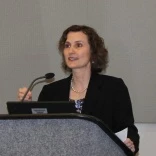The economic empowerment of women is gaining prominence in the development agenda. It is reflected in Millennium Development Goal 3 and will be the focus of the World Bank’s World Development Report 2012. Expanding women’s access to income generating opportunities is a key part of this objective. An important starting point is to understand where women work.
Two figures based on data from household and labor force surveys in 137 low- and middle-income countries help answer this question. Figure 1, focused only on women, reports the shares active in different types of employment. Figure 2, focused on the nonagricultural labor force (male and female), reports the share of workers in each employment category who are women. Thus the first shows the distribution of women across types of work, and the second the differences in the rates at which men and women are active in the same type of employment.
Figure 1 shows the average patterns by country income level. While there are variations around these lines—reflecting differences in countries’ endowments, cultural practices relating to women’s labor force participation, and the like—income level is correlated with a number of outcomes.
The top line shows the widely documented U shape of women’s labor force participation. Rates are very high at low levels of income—largely reflecting the need for subsistence agricultural labor and rise again in upper middle-income countries (note that the figures do not include high-income countries, so the trends on the right sides of the graphs are truncated).
Figure 1

This overall U pattern masks changes in the composition of women’s employment across country income levels that the other lines reveal:
- The share of women in agriculture falls dramatically with income.
- Women’s wage employment rises significantly with income.
- Self-employment is less sensitive to income levels, although it falls somewhat at higher levels of income.
- But across income levels, very few women are employers.
How do these patterns differ from those among men? Figure 2 illustrates. The first thing to note is that women’s share of the nonagricultural labor force is remarkably constant across income levels, at just under 40 percent.
Figure 2

Again there are compositional differences underlying the overall pattern:
- The most dramatic result is that women’s share of wage employment rises from 20 percent at lower income levels to nearly 50 percent at higher levels. Thus while figure 1 shows that women’s wage employment rises with income, figure 2 shows that women benefit disproportionately with this trend such that their share of wage employment nears parity at higher levels of income.
- Women make up a large share of entrepreneurs. But they are concentrated in self-employment rather than among employers. Indeed, in low- and lower-middle-income countries women make up nearly half the self-employed. This share exceeds women’s share of the overall non-agricultural labor force. Thus women are disproportionately in self-employment at lower levels of income.
- The share of women among employers is relatively constant across income levels. This share is just above 25 percent, significantly lower than women’s share of the overall non-agricultural labor force.
The data in these two figures show the patterns across types of employment. Additional data from Enterprise Surveys show further sorting across sectors and occupations within these categories.
What do the data suggest about ways to increase women’s economic empowerment? In many countries the issue is not increasing women’s labor force participation. Instead, it is enabling women to move into higher-return activities. This can be through encouraging women to choose different sectors, but also in addressing constraints to growth, enabling women to move from self-employment to becoming an employer and to expand their businesses. Or, it may mean enabling women to compete successfully for wage employment—particularly in lower-income countries, where men secure most of these more stable and higher-paying positions.
The World Bank’s Africa Region, in collaboration with the Office of the Chief Economist Office in the Financial and Private Sector Development Network, is carrying out an in-depth analysis of these issues and their policy implications. A regional flagship report, Expanding Economic Opportunities for Women in Africa (with Mary Hallward-Driemeier as task team leader) will be disseminated later this year. Additional topics and findings will be discussed in future blog posts.


Join the Conversation